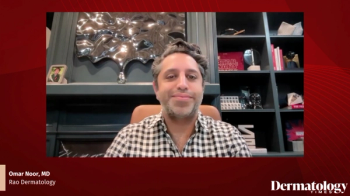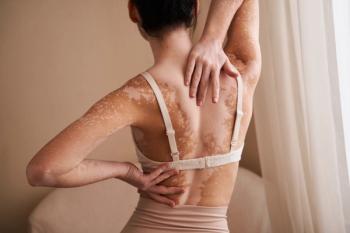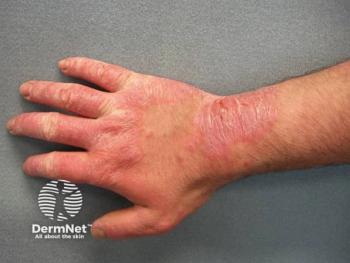
- Dermatology Times, July 2025 (Vol. 46. No. 07)
- Volume 46
- Issue 07
Integrating Trifarotene and Topical Retinoids Into Acne and Acne Sequelae Management
Key Takeaways
- Adult acne presents a chronic inflammatory disorder with significant psychosocial impacts, including scarring and hyperpigmentation, necessitating early intervention.
- Trifarotene, a fourth-generation RAR-γ selective retinoid, shows efficacy in reducing atrophic scars and hyperpigmentation, especially in diverse skin types.
Discover how trifarotene, a novel retinoid, effectively addresses adult acne and its long-term effects, enhancing skin health and quality of life.
Adult acne is increasingly recognized as a chronic inflammatory disorder with a wide spectrum of presentations and a significant psychosocial burden.1 Beyond the visible lesions, postacne sequelae, including atrophic scars, acne-induced hyperpigmentation (AIH), and persistent erythema, are major contributors to long-term patient dissatisfaction, reduced quality of life, and psychological distress.
“While having acne in of itself is distressing, postacne sequelae also has a significant quality-of-life impact on patients, particularly scars and postinflammatory hyperpigmentation and erythema. Early intervention is absolutely critical to reduce the risk of any acne lesion leading to scarring or pigmentary change,” Naiem Issa, MD, PhD, said in a conversation with Dermatology Times. Issa is a study author and dermatologist at Forefront Dermatology in Vienna, Virgina.
Topical retinoids have become a cornerstone of acne treatment. Their utility extends beyond lesion clearance to include prevention and improvement of acne sequelae through modulation of inflammation, normalization of keratinization, and stimulation of collagen synthesis.
Among the newer topical agents, trifarotene 0.005% cream (Aklief; Galderma), a fourth-generation RAR-γ selective retinoid, has emerged as a promising therapeutic option with demonstrated efficacy across multiple end points, including scarring and pigmentary changes.
Existing Data on Trifarotene’s Efficacy
Recent clinical commentary from Issa et al analyzed research on trifarotene and provides recommendations for providers looking to implement retinoid therapy in practice.2 Several studies have assessed the efficacy of traditional retinoids such as adapalene, tretinoin, and tazarotene for acne sequelae. However, trifarotene is the only topical retinoid evaluated in 2 large-scale, randomized, phase 4 trials specifically targeting atrophic acne scars and AIH across all Fitzpatrick skin types.
The phase 4 START study (NCT04856904) evaluated trifarotene in patients with acne and associated atrophic scarring.3 Results showed a significant reduction in total scar count at week 24 compared with vehicle (55.2% vs 29.9%; P = .001), with improvements seen as early as week 2. Post hoc analyses revealed the most notable scar improvement occurred in patients over age 27, underscoring the value of trifarotene in managing adult acne, which is frequently characterized by inflammation and scarring.
The phase 4 LEAP trial (NCT05089708), which focused on AIH, did not meet its primary end point of change in overall disease severity.4 However, significant improvements in postacne hyperpigmentation index scores were observed in the trifarotene arm compared with vehicle by week 24 (−18.9% vs −11.3%). This study enrolled patients across the spectrum of Fitzpatrick skin phototypes, with many patients exhibiting darker skin tones, a population disproportionately affected by pigmentary sequelae and historically underrepresented in clinical research.
“A major unmet need in acne treatment has been the lack of randomized, vehicle-controlled trials with post-acne sequelae—such as scarring and hyperpigmentation—as primary end points,” Issa said. “These studies demonstrated that trifarotene significantly improves acne sequelae, including scarring and hyperpigmentation, across all Fitzpatrick skin types. This supports its role as a novel therapeutic option for both active acne and its long-term consequences in diverse patient populations.”
Clinical Recommendations for Patient Care
With this existing literature in mind, Issa et al outlined several guidelines for clinicians to consider when exploring retinoids, including trifarotene as a first-line therapy for patients with acne and acne sequelae.
Initiate Retinoids Early and Maintain Use
Retinoids should be initiated early in patients with active acne to reduce lesion count, prevent new comedones, and blunt the inflammatory cascade that leads to scarring and pigmentation. Studies show delayed treatment is a modifiable risk factor for atrophic scarring. Given its favorable tolerability and safety profile, trifarotene is well suited for early intervention and long-term maintenance. Trifarotene phase 4 studies have had the most participants when compared with trials of adapalene and tretinoin, for example. However, there have been no head-to-head studies comparing these retinoids with trifarotene.
Address Acne Sequelae Proactively in Skin of Color
AIH is significantly more prevalent and persistent in individuals with Fitzpatrick skin types IV to VI, as reported prevalence rates range from 45.5% to 87.2%. Given the heightened risk and slower resolution of hyperpigmentation due to increased melanin density, proactive use of topical retinoids in combination with photoprotection is essential. Trifarotene’s efficacy in skin of color, as demonstrated in LEAP, makes it an important option in these populations.
Incorporate Retinoids Into a Comprehensive Skin Care Regimen
Photoprotection is an often-underemphasized adjunct in the management of acne sequelae. Sunscreen use not only helps prevent further hyperpigmentation but may also improve the efficacy of retinoid therapy. In the LEAP study, the improvements in the population were attributed to the inclusion of SPF 30 in the study-mandated skin care regimen. After 12 weeks of trifarotene therapy, a rapid reduction in AIH (P = .03) was demonstrated. Thus, sunscreen application alongside retinoid therapy is critical for patients at risk of AIH.
Utilize Retinoids as a Maintenance Therapy Option
Retinoids are not only effective during active disease flares but also serve as effective maintenance agents to prevent recurrence and reduce scarring. In the START study, adherence rates exceeded 80% at week 24, and adverse events were largely mild or moderate. This supports the long-term use of trifarotene as part of a comprehensive, chronic management approach, particularly in patients with a history of scarring or adult-onset acne.
Overcome Adherence and Prescribing Barriers
Despite their well-established benefits and robust clinical research, retinoids remain underutilized in clinical practice, particularly among adult patients and in primary care settings. Data show that nondermatologists prescribe retinoids in only one-third of acne cases. To address this gap, referral pathways should be optimized, and educational efforts should target both patients and providers to address misconceptions and increase awareness about the long-term benefits of early retinoid initiation. It has been proven that patients are 4 times more likely to follow clinician directions when the role of products is explained properly compared with when no education is given.5
Future Investigations to Enhance Acne Care With Retinoids
The current guidelines from the American Academy of Dermatology recognize the need for formalized treatment approaches to acne sequelae.6 Thus, future studies should explore profiles associated with tolerability, scarring, and pigmentary changes, particularly in diverse patient populations. Additional research should aim to stratify patients by risk and identify early predictors of sequelae development, enabling more personalized, evidence-based treatment regimens.
There is also a growing need to reevaluate traditional skin classification systems. The Fitzpatrick scale, while commonly used, was originally developed for phototherapy dosing and may be inadequate for guiding pigmentary disorder treatment. More objective and inclusive classification systems could improve clinical trial design and ensure more equitable treatment strategies for patients with skin of color.
Topical retinoids remain a fundamental tool in acne therapy, not only for active disease management but also for mitigating long-term sequelae. Trifarotene, with its RAR-γ selectivity and strong data from both phase 3 and 4 trials, offers clinicians a well-tolerated and effective option that is particularly relevant for adult patients and those with skin of color. Clinicians should feel confident integrating trifarotene into early, maintenance, and combination regimens to optimize both short- and long-term outcomes in acne care.
References
- Zaenglein AL, Pathy AL, Schlosser BJ, et al. Guidelines of care for the management of acne vulgaris. J Am Acad Dermatol. 2016;74(5):945-973.e33. doi:10.1016/j.jaad.2015.12.037
- Issa N, Alexis A, Baldwin H, et al. Recommendations to improve outcomes in acne and acne sequelae: a focus on trifarotene and other retinoids. Dermatol Ther (Heidelb). 2025;15(3):563-577. doi:10.1007/s13555-025-01344-y
- Schleicher S, Moore A, Rafal E, et al. Trifarotene reduces risk for atrophic acne scars: results from a phase 4 controlled study. Dermatol Ther (Heidelb). 2023;13(12):3085-3096. doi:10.1007/s13555-023-01042-7
- Alexis A, Del Rosso JQ, Forman S, et al. Importance of treating acne sequelae in skin of color: 6-month phase IV study of trifarotene with an appropriate skincare routine including UV protection in acne-induced post-inflammatory hyperpigmentation. Int J Dermatol. 2024;63(6):806-815. doi:10.1111/ijd.17189
- Berson D. Recommendation of moisturizers and cleansers: a study of unmet needs among dermatology patients. Cutis. 2005;76(6 suppl):3-6.
- Reynolds RV, Yeung H, Cheng CE, et al. Guidelines of care for the management of acne vulgaris. J Am Acad Dermatol. 2024;90(5):1006.e1-1006.e30. doi:10.1016/j.jaad.2023.12.017
Articles in this issue
5 months ago
Dermatology Times July 2025 Print Recap5 months ago
Is AI Transforming Skin Care?5 months ago
The Value of RAD, According to Clinicians5 months ago
A New Canvas for Conversations in DermatologyNewsletter
Like what you’re reading? Subscribe to Dermatology Times for weekly updates on therapies, innovations, and real-world practice tips.



















